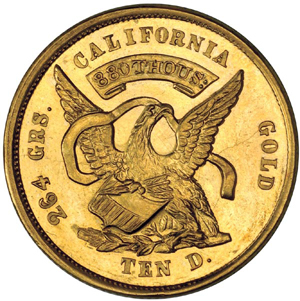 A truly special example of this rare issue, a near-twin to the Specimen-67 (PCGS) sold for a record-shattering $948,750 in August 2006. Bold cartwheel lustre encircles exemplary light yellow gold surfaces. The fields are remarkably reflective, essentially fully prooflike. While this does not have quite the extent of "flash" of the unique Specimen striking, which was once Humbert's personal coin, the reflectivity is greater than any other example seen. Indeed, if the other Moffat $10 had not recently crossed our desks, we would be sorely tempted to call this a Specimen. Even in the shadow of that coin, the mirrors are impressive and the overall preservation is highly unusual for any territorial coin.
A truly special example of this rare issue, a near-twin to the Specimen-67 (PCGS) sold for a record-shattering $948,750 in August 2006. Bold cartwheel lustre encircles exemplary light yellow gold surfaces. The fields are remarkably reflective, essentially fully prooflike. While this does not have quite the extent of "flash" of the unique Specimen striking, which was once Humbert's personal coin, the reflectivity is greater than any other example seen. Indeed, if the other Moffat $10 had not recently crossed our desks, we would be sorely tempted to call this a Specimen. Even in the shadow of that coin, the mirrors are impressive and the overall preservation is highly unusual for any territorial coin.
Some light hairlines are seen in the fields, but no bagmarks or nicks are seen. This piece has clearly seen no circulation, just some minor handling. Shallow abrasions are noted on either side of star 7, another near a minuscule nick above star 1. A natural depression may be seen on the cheek, a useful identifying mark. Clearly this piece was preserved away from coins bound for circulation, and calling it a possible presentation piece does not seem overly speculative considering that we know another was made.
The die state is essentially identical to the Specimen-67, with the polished fields still showing circular lathe marks around the devices. The faint reverse die cracks present on the other piece are present, as are the fine lapping marks in protected areas. A tiny rim cud below star 13 looks essentially as it does on the Specimen-67 coin, though in general the bottom obverse rims of that piece were a bit more boldly defined. That example showed two lint marks outside obverse stars; we do not detect the presence of those tiny strands of lint on the die when this piece was struck.
 As beautiful as this coin is, as spectacular as its state of preservation is, it is seemingly bound to be considered "the other coin." If the Humbert Specimen-67 example was the first 1852 Moffat $10 coined, this one was second, third, or somewhere in close order behind it. The intent of the minter was clear on the other specimen, but this piece was undoubtedly coined soon after while the fields were still deeply prooflike.
As beautiful as this coin is, as spectacular as its state of preservation is, it is seemingly bound to be considered "the other coin." If the Humbert Specimen-67 example was the first 1852 Moffat $10 coined, this one was second, third, or somewhere in close order behind it. The intent of the minter was clear on the other specimen, but this piece was undoubtedly coined soon after while the fields were still deeply prooflike.
When the present writer catalogued the magnificent Specimen-67 1852 Moffat $10 for our August 2006 sale, the provenances for this specimen and that example were unfortunately and erroneously intertwined, despite the gut feeling that something wasn't quite right. The fact that a prooflike gem example of that issue appeared in the 1948 Memorable sale was befuddling: how could the coin escape the Brand estate to appear in that sale, yet still appear in a 1964 sale of selections from the Brand estate? The mystery is now solved, now that we know there are two highly reflective specimens of the Moffat $10 extant. Kosoff's description from 1948—"acquired as a brilliant proof, with which we disagree, although the coin has a proof-like lustre"—did not seem to fit the Specimen-67 example, which looks as Proof as any coin from California of the era could. Further confusion came from RARCOA's 1982 description of the specimen presently offered, in which this coin was called "unquestionably THE FINEST KNOWN example." It appears the RARCOA cataloguer did not know of the Specimen-67 example. With the present specimen in front of us, it is easy to see that the plates in the 1948 Memorable sale and Auction '82, neither of superb quality, showcase this exact coin. When this piece appeared on our desk, it was a "Eureka!" moment, since the presence of the ex. Brand Specimen-67 in the 1948 "Memorable" sale was difficult to understand. From the Archangel Collection. Previously from Numismatic Gallery (Abe Kosoff and Abner Kreisberg)'s sale of the "Memorable" Collection (i.e. Jacob Shapiro or "Bell"), March 1948, Lot 970; RARCOA's session of Auction '82, August 1982, Lot 981. Plated in the Kagin's Private Gold Coins.
© 2006 Heritage Galleries. Photograph by Jody Graver. Used with permission of Steve Ivy and Heritage Galleries.